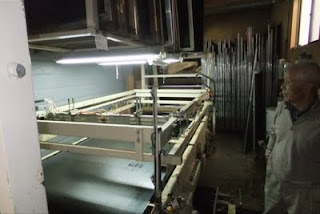This tenugui factory is run by a family called Nakagawa-san and is located in Utsunomiya city approximately 100km north of Tokyo. The factory lasting for over 100 years is not so modern or neat, but the family is keeping the spirits of hand-dyeing tenugui.
This snapshot shows an old lady at the factory pouring dyeing material onto tenugui.
We drove a car to the factory to take photos.
This is another snapshot of an old man preparing for dyeing cloth.
All tenugui is hand-dyed and produced one-by-one. The design of tenugui has a stock from ancient Ukiyo-e pictures to contemporary style. The tenugui has a variety of usage such as home decor, head towel, hotel towel, handkerchief, dust cover and more. What is good about tenugui is that it so thin that it dries very quickly.
 |
| Ukiyo-e design tenugui |
- Ken
http://www.nipponcraft.com/













